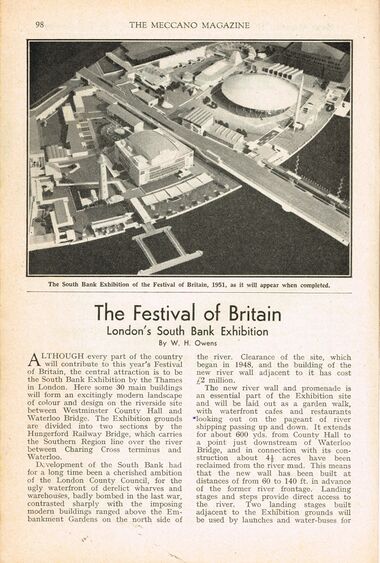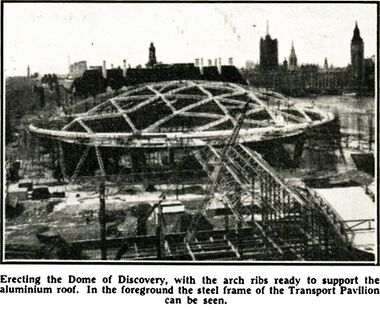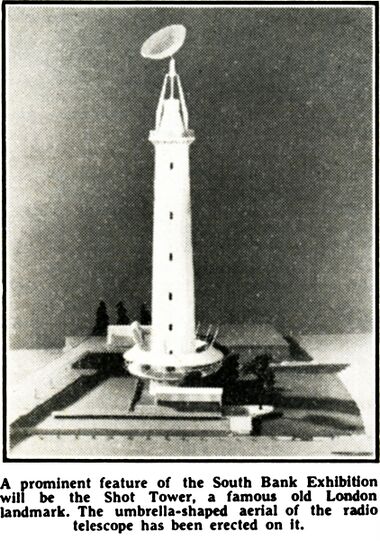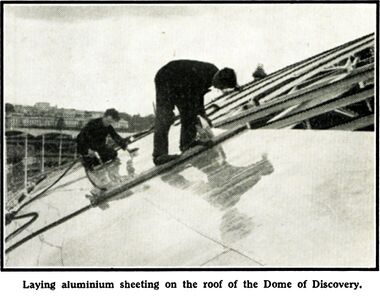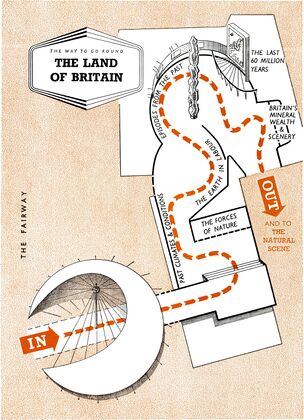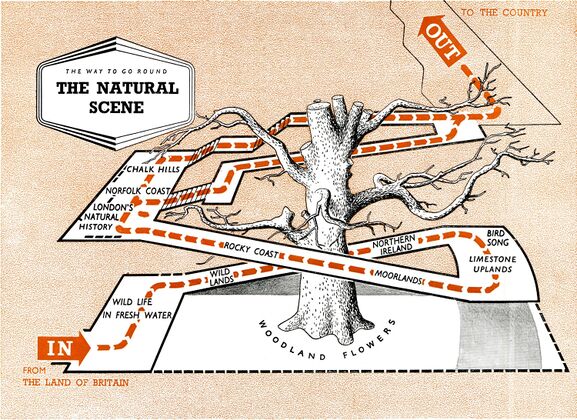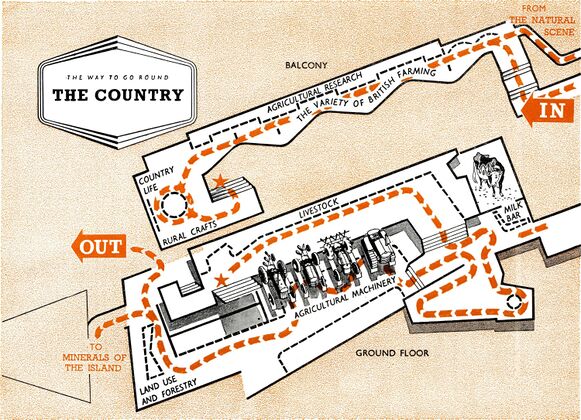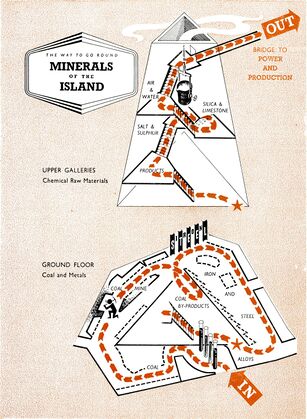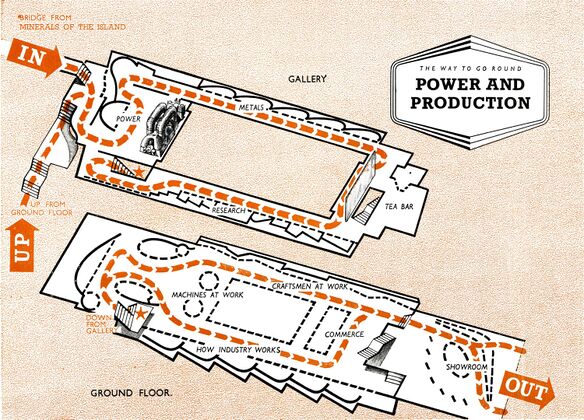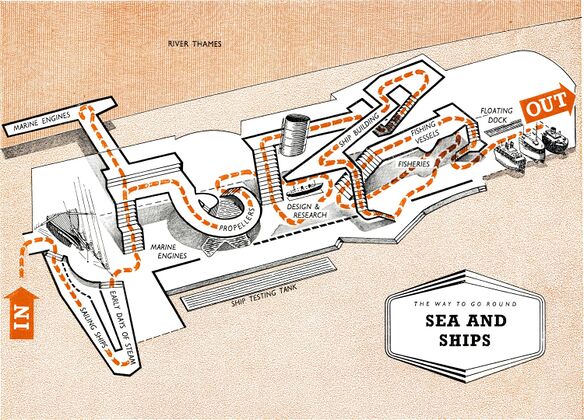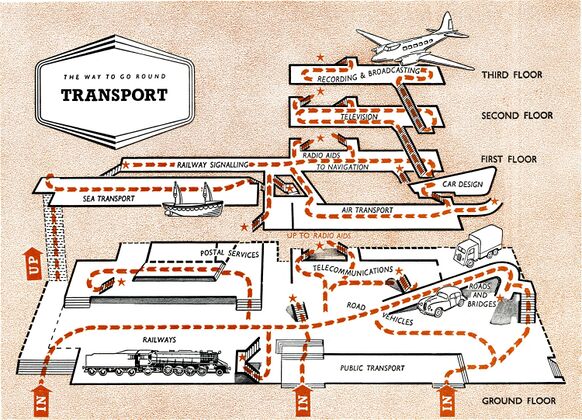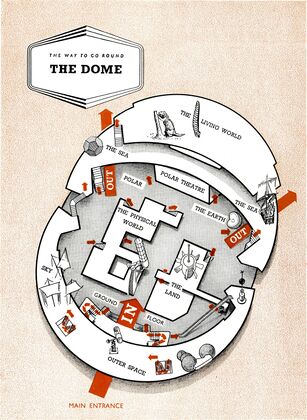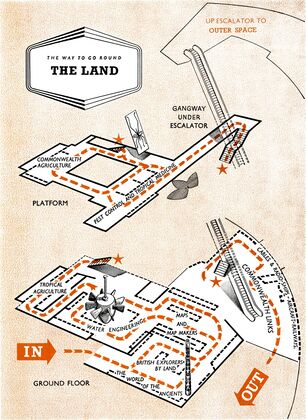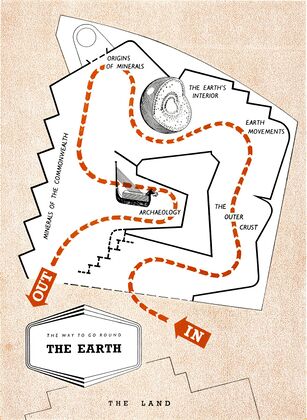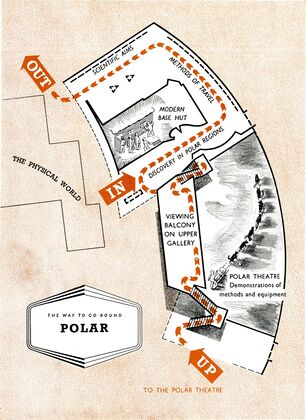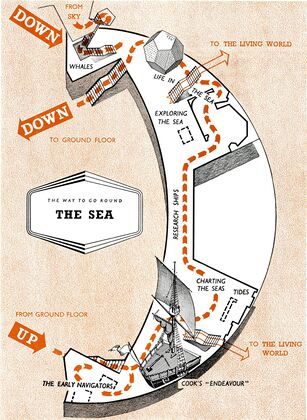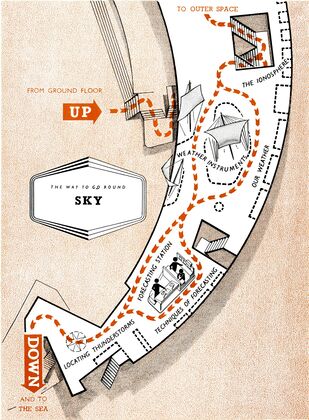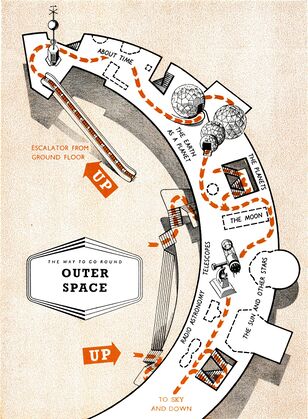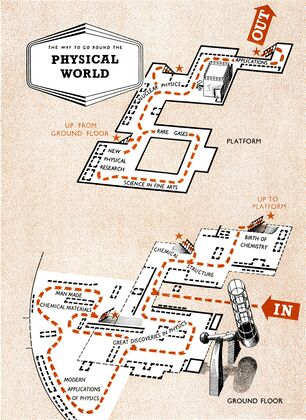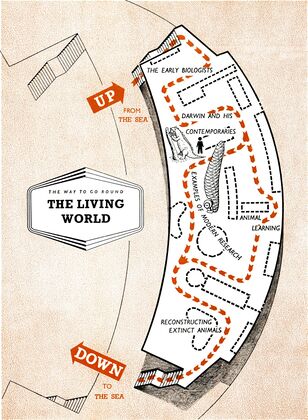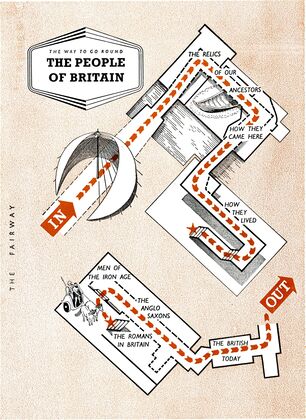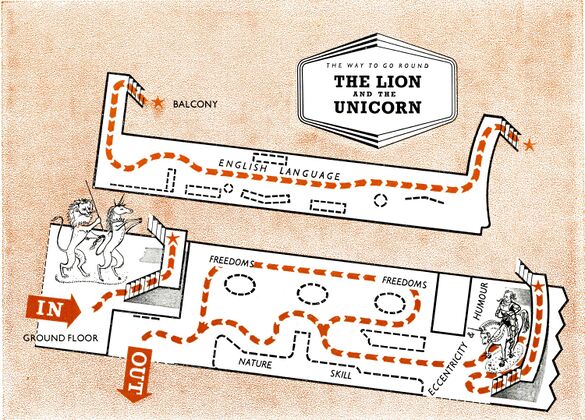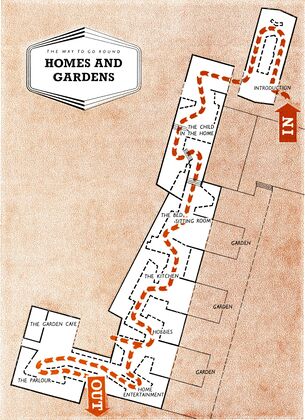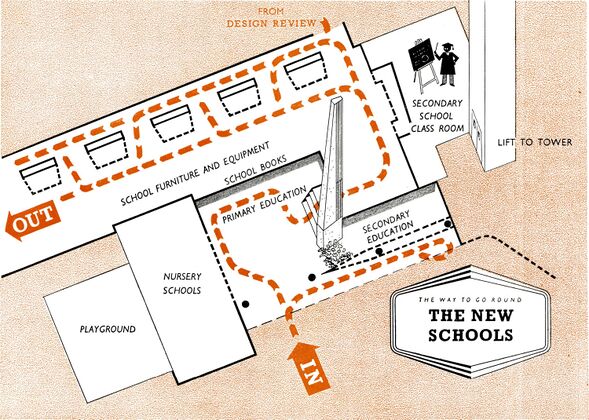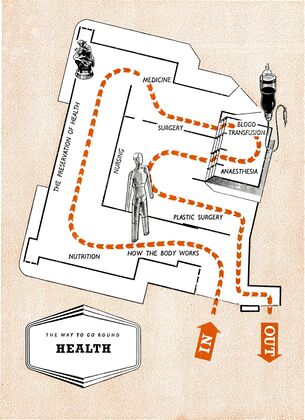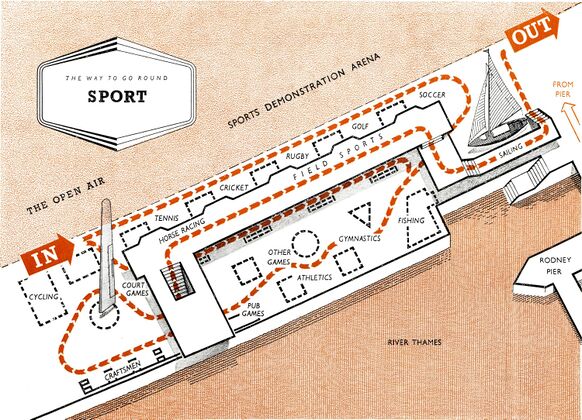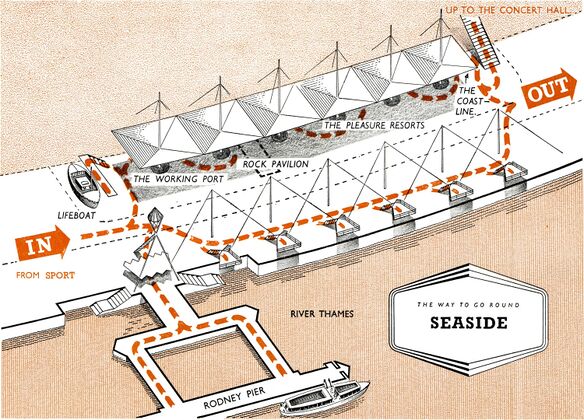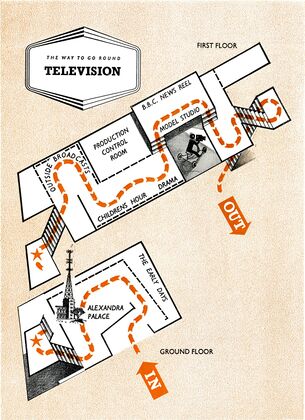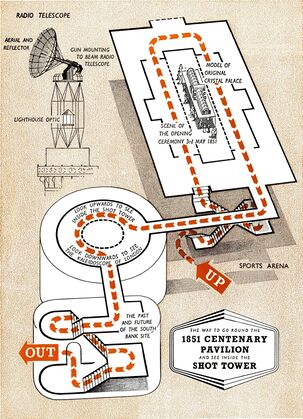Category:Festival of Britain (1951)
Major Exhibitions : 1851 Great Exhibition || 1900 Paris Exhibition | 1908 Franco-British | 1924 British Empire | 1933 Chicago WF | 1938 Empire, Glasgow | 1939 New York WF | 1951 Festival of Britain | |
The Festival of Britain was held in 1951, on the centenary of the 1851 Great Exhibition. The festival took place mainly on London's South Bank site, but with auxiliary exhibitions at other locations in and outside London, supplemented with two travelling exhibitions, moving by land and sea. The "entertainment" section of the exhibition, which wouldn't fit into the main South Bank site, was set up at Battersea Park.
The festival was hoped to raise national spirits in the period of postwar austerity after World War Two, and had a modernist, forward-looking theme.
Most of the festival's buildings were demolished on the orders of the incoming Conservative government. This included the Skylon, a lightweight illuminated 250-foot high tapered cigar-shaped pylon suspended 40 feet in the air, which was a popular landmark with the public. The main remaining structure on the site, which is still in use, is the Royal Festival Hall.
Model
The Festival of Britain' architectural mode was made by Denis Hefford.
1951 description:
1951: "The South Bank Exhibition of the Festival of Britain, 1951, as it will appear when completed." [image info]
1951: "Erecting the Dome of Discovery, with the arch ribs ready to support the aluminium roof. In the foreground the steel frame of the Transport Pavilion can be seen." [image info]
1951: "A prominent feature of the South Bank Exhibition will be the Shot Tower, a famous old London landmark. The umbrella-shaped aerial of the radio telescope has been erected on it." [image info]
1951: "Laying aluminium sheeting on the roof of the Dome of Discovery. ..." [image info]
The Festival of Britain
London's South Bank ExhibitionALTHOUGH every part of the country will contribute to this year's Festival of Britain, the central attraction is to be the South Bank Exhibition by the Thames in London. Here some 30 main buildings will form an excitingly modern landscape of colour and design on the riverside site between Westminster County Hall and Waterloo Bridge. The Exhibition grounds are divided into two sections by the Hungerford Railway Bridge, which carries the Southern Region line over the river between Charing Cross terminus and Waterloo.
Development of the South Bank had for a long time been a cherished ambition of the London County Council, for the ugly waterfront of derelict wharves and warehouses, badly bombed in the last war, contrasted sharply with the imposing modern buildings ranged above the Embankment Gardens on the north side of the river. Clearance of the site, which began in 1948, and the building of the new river wall adjacent to it has cost £2 million.
The new river wall and promenade is an essential part of the Exhibition site and will be laid out as a garden walk, with waterfront cafes and restaurants looking out on the pageant of river shipping passing up and down. It extends for about 600 yds. from County Hall to a point just downstream of Waterloo Bridge, and in connection with its construction about 4½ acres have been reclaimed from the river mud. This means that the new wall has been built at distances of from 60 to 140 ft. in advance of the former river frontage. Landing stages and steps provide direct access to the river. Two landing stages built adjacent to the Exhibition grounds will be used by launches and water-buses for carrying visitors between the South Bank and the Festival Pleasure Gardens in Battersea Park, further upstream.
That the construction of the river wall is the largest civil engineering job undertaken by the L.C.C. since the war may be appreciated from the quantities of materials used. These included 22,000 cu. yds. of concrete, 50,000 cu. ft. of granite and 1,500 tons of steel for use in temporary cofferdams. Construction was carried on in the dry, inside the cofferdams, and to provide working platforms and protect the works in course of building, temporary timber stagings were erected in the river. The timber used was salvaged from emergency Thames bridges erected during the war.
The purpose of this Exhibition is to tell the story of Britain's past and present achievements, and to show some of her actual plans for future development. The story is to be unfolded in panorama form by means of selective displays drawn chiefly from the fields of science, technology and industrial design. These displays will be seen in a series of pavilions, each of which is to be devoted to some typical aspect of life in these islands; for example, Discovery and Exploration, Industry, Transport, Rural Life the Home, the Sea and Sport.
Thus in a tour right round the Exhibition the visitor will find a continuous visual story of the living, working Britain of to-day. Although this is not a trade fair, many of the best designed products of our factories will nevertheless form a very important part of the displays.
Buildings for an exhibition of this size presented something of a problem in these days of material shortages. But the choice of temporary fabric structures, involving the use of many different kinds of materials, has solved that problem in a way that is certain to prove visually exciting and stimulating for all who visit the South Bank between May and October. The first impression will be one of bold architectural contrast in colour and outline, and some of the structures will be of quite thrilling shape and fantastic design such as have not been seen in Britain before.
A typical example of the futuristic patterns which may be seen on the South Bank is what is known as the Vertical Feature, which looks rather like a rocket about to be fired to the Moon. This will act as an enormous "pointer" to the Exhibition, shining in sunlight by day and illuminated from the inside by night. It will create the illusion of a heavier-than-air structure defying the laws of gravity, with its base suspended in a cradle of steel cables 40 ft. above the ground. The cradle is supported on three aluminium.- tube, lattice-style pylons, each 68 ft. high.
The Feature itself is a twelve-sided aluminium frame, 250 ft. high and 14 ft. wide halfway up, tapering in curves to its upper and lower ends. After nightfall it will appear as a blazing pillar of light suspended over the Exhibition and pointing down to it. Tungsten-filament electric lighting is uniformly distributed throughout the length of the object to give an intense light.
The most striking of the Exhibition pavilions is the Dome of Discovery, the largest dome in the world, which is 365 ft. in diameter and 93 ft. to the apex. It will be used to tell the wonderful story of British pre-eminence aying in discovery and exploration. The saucer-shaped dome consists of built-up ribs, intermediate rafters, purloins and sheeting all made of aluminium alloy. It is supported on a circular ring girder of welded steel, that in turn stands on tubular steel struts 45 ft above the ground. Inside the dome are three galleries, placed at levels of 35 ft., 22 ft. and 12 ft. respectively and supported on reinforced concrete fins and steel framework. It is on these galleries that the displays will be shown.
The range of subject matter being put on view in the Dome of Discovery is very wide indeed, for it embraces discovery and exploration by land and sea and into the very nature of the universe. Side by side with the achievements of such famous explorers as Cook and Livingstone will be displayed the discoveries of distinguished British scientists like Newton, Darwin, Faraday, Thomson and Rutherford. One section will show the latest knowledge of the structure and nature of matter, culminating in a display of nuclear energy. Others will be concerned with land, sea and Polar exploration, Inner Space, Outer Space and the living world. There will be specially designed models and working demonstrations illustrative of scientific discovery, and also such realistic displays as, for example, a reconstruction of an Antarctic scene, with the most modern polar equipment and live sledge dogs.
Another interesting feature of the Exhibition is the Shot Tower. This of course is not new at all, but is one of the famous old landmarks of London's riverside. It was built in 1789 to manufacture shot for sporting guns and was used for that purpose until recently. Molten lead released from the top of the 140 ft. tower cooled and formed the small globules that were finally passed out as shot. Visitors to the Exhibition will not be able to climb the Shot Tower, but its summit is to be used as a lighthouse and to mount the large aluminium aerial of a radio telescope, the latest scientific aid of astronomers. This umbrella-shaped aerial, 30 ft. in diameter, will be rotated by remote control from the "Outer Space" section of the Dome of Discovery. Visitors to the Dome will thus be able to see, and perhaps hear, radio waves from the Sun and stars, and even from meteors. They may also transmit radio signals to the Moon and, in a matter of two or three seconds, watch their reflection back to earth again. Progress of the radio signals in transit will be watched on a large cathode ray tube similar to those used in television.
Railway enthusiasts are promised a feature of special interest in the shape of a French 2-2-2 Buddicom locomotive, 110 years old and still in perfect working condition. An article on this engine, of British design, appears on page 109 of this issue.
— , W. H. Owens, , The Festival of Britain, , Meccano Magazine, , March 1951
Sequence
The Exhibition, which tells a continuous story, will make most sense if the Pavilions are visited in the order shown; but each Pavilion can be visited separately if so desired.
"THE LAND"
- 1: The Land of Britain – How the natural wealth of the British Isles came into being.
- 2: The Natural Scene – The rich and varied wild life that inhabits these islands.
- 3: The Country – A highly mechaniscd and most efficiently farmed countryside results from long experience, aided by science and engineering.
- 4: Minerals of the Island – How the British have drawn on their natural resources to produce raw materials for industry.
- 5: Power and Production – Highlights in the growth of present-day industry—the lifeline of Britain, with many examples of first-class design and production.
- 6: Sea and Ships – Shipbuilding, propelling machinery and the fisheries.
- 7: Transport – British pioneering, and contemporary achievement in design, for Communications and transport by Road, Rail, Air and Sea.
THE DOME OF DISCOVERY
British initiative in exploration and discovery is as strong to-day as ever it was.
- 8: The Land – Exploration leads to development of overseas territories. Science and technology provide the tools and methods.
- 9: The Earth – Science is revealing the age and structure of the earth. Technology develops its underground resources.
- 10: Polar – A great tradition now applied particularly to scientific discovery and aided by mechanisation. Demonstrations in the Polar theatre.
- 11: Sea – The great heritage of Drake and Cook has passed to the marine scientists who are yearly adding to our knowledge of the sea.
- 12: Sky – Weather forecasting and research. Exploration into the ionosphere, which improves long-distance radio communication.
- 13: Outer Space – What we have learned from the old astronomy of Newton, and from the new astronomy which uses radio methods.
- 14: The Physical World – Explorations into the nature and behaviour of matter have made possible many of the material achievements of the present age.
- 15: The Living World – Discoveries of the secrets of life. Darwin's great influence in the world of thought. Contemporary biological research.
THE PEOPLE
- 16: The People of Britain – We are a people of mixed ancestry and now a blend of many different qualities.
- 17: The Lion and the Unicorn – Clues to British character and tradition. The Lion symbolises action the Unicorn imagination.
- 18: Homes & Gardens – Many people on a small island create an urgent problem of space. Here are new solutions for six such problems in the home.
- 19: The New Schools – Equipment and classrooms from the new schools in Britain.
- 20: Health – British pioneering and modern achievement in public health, medicine, surgery and nursing.
- 21: Sport – Most sports originated in Britain and we have carried them around the world. Craftsmen at work.
- 22: Seaside – Our maritime character as expressed at home—the port, the seaside resort, the wild coastline between them. (Pages 81-82.)
OTHER DISPLAYS
- 23': Television – Its development: how television shows are put on.
- 24: Telecinema – First showings of new British documentary films in one-hourly programmes: large-screen television.
- 25: 1851 Centenary Pavilion – Recalls, in model form, the original Crystal Palace and its Royal opening in 1851.
- 26: Shot Tower – Aerial and reflector of the radio telescope.; lighthouse optic and lantern; at base, a small display about the South Bank.
- 27: Design Review – A novel display, with information service, of 25,000 photographs illustrating the wide range of British manufactures.
External links
- South Bank Exhibition - poster, 1951 Educational poster published by the Bureau of Current Affairs showing a model of the Festival of Britain on London's South Bank (unionhistory.info)
- Art for Social Spaces: The Festival of Britain (vads.ac.uk)
- Festival of Britain: fun that forged the future (telegraph.co.uk)
- Archaeology at the Festival of Britain (archaeologyuk.org)
- Skylon Tower, Festival of Britain (architecture.com)
Media in category ‘Festival of Britain (1951)’
The following 28 files are in this category, out of 28 total.
- Cladding the Dome of Discovery, Festival of Britain (MM 1951-03).jpg 1,200 × 939; 239 KB
- Erecting the Dome of Discovery, Festival of Britain (MM 1951-03).jpg 1,200 × 980; 308 KB
- Festival of Britain - Dome of Discovery (FoBG 1951).jpg 2,191 × 3,000; 1.77 MB
- Festival of Britain 01 - Land of Britain (FoBG 1951).jpg 2,173 × 3,000; 1.57 MB
- Festival of Britain 02 - Natural Scene (FoBG 1951).jpg 3,000 × 2,183; 1.92 MB
- Festival of Britain 03 - Country (FoBG 1951).jpg 3,000 × 2,171; 1.73 MB
- Festival of Britain 04 - Minerals of the Island (FoBG 1951).jpg 2,197 × 3,000; 1.72 MB
- Festival of Britain 05 - Power and Production (FoBG 1951).jpg 3,000 × 2,159; 1.74 MB
- Festival of Britain 06 - Sea and Ships (FoBG 1951).jpg 3,000 × 2,158; 1.87 MB
- Festival of Britain 07 - Transport (FoBG 1951).jpg 3,000 × 2,164; 1.75 MB
- Festival of Britain 08 - Land (FoBG 1951).jpg 2,187 × 3,000; 1.69 MB
- Festival of Britain 09 - Earth (FoBG 1951).jpg 2,193 × 3,000; 1.42 MB
- Festival of Britain 10 - Polar (FoBG 1951).jpg 2,186 × 3,000; 1.73 MB
- Festival of Britain 11 - Sea (FoBG 1951).jpg 2,191 × 3,000; 1.85 MB
- Festival of Britain 12 - Sky (FoBG 1951).jpg 2,207 × 3,000; 1.87 MB
- Festival of Britain 13 - Outer Space (FoBG 1951).jpg 2,204 × 3,000; 1.74 MB
- Festival of Britain 14 - Physical World (FoBG 1951).jpg 2,185 × 3,000; 1.78 MB
- Festival of Britain 15 - Living World (FoBG 1951).jpg 2,199 × 3,000; 1.7 MB
- Festival of Britain 16 - People of Britain (FoBG 1951).jpg 2,185 × 3,000; 1.83 MB
- Festival of Britain 17 - Lion and Unicorn (FoBG 1951).jpg 3,000 × 2,156; 1.71 MB
- Festival of Britain 19 - New Schools (FoBG 1951).jpg 3,000 × 2,139; 1.43 MB
- Festival of Britain 20 - Health (FoBG 1951).jpg 2,178 × 3,000; 1.49 MB
- Festival of Britain 21 - Sport (FoBG 1951).jpg 3,000 × 2,165; 1.67 MB
- Festival of Britain 22 - Seaside (FoBG 1951).jpg 3,000 × 2,157; 1.6 MB
- Festival of Britain 23 - Television (FoBG 1951).jpg 2,181 × 3,000; 1.64 MB
- Festival of Britain 25 26 - 1851 Centenary and Shot Tower (FoBG 1951).jpg 2,167 × 3,000; 1.72 MB
- The Festival of Britain (MM 1951-03).jpg 1,486 × 2,200; 1.9 MB
- The Shot Tower, Festival of Britain (MM 1951-03).jpg 843 × 1,200; 297 KB
